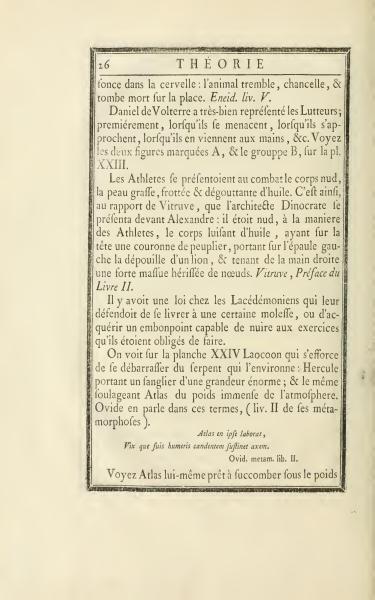THEORY
Daniel of Volterra has very well represented the Wrestlers; first when they threaten each other, when they approach each other, when they come to grips, etc. See the two figures marked A, and the group B, on plate XXIII.
Athletes presented themselves to combat with their bodies bare, the skin greasy, rubbed and dripping with oil. Thus, according to Vitruvius, the architect Dinocrates appeared before Alexander: he was naked, like the Athletes, the body gleaming with oil, having on his head a crown of poplar, carrying on his left shoulder the skin of a lion, and holding in his right hand a strong club bristling with knots. Vitruvius, Preface of Book II.
There was a law among the Lacedaemonians which forbade them from indulging in a certain softness, or acquiring a corpulence capable of hindering the exercises they were obliged to perform.
On plate XXIV, we see Laocoon striving to rid himself of the serpent that surrounds him: Hercules carrying a boar of enormous size, and similarly relieving Atlas of the immense weight of the atmosphere. Ovid speaks of it in these terms (book II of his Metamorphoses).
Atlas himself suffers, scarcely able to support the burning axis on his shoulders. Ovid, Metamorphoses, book II.
See Atlas himself ready to succumb under the weight.
Translation Notes
- "Volterra": Referring to Daniele da Volterra, a renowned Italian painter and sculptor.
- "Vitruvius": A Roman author and architect known for his work "De architectura."
- "Dinocrates": An ancient Greek architect known for his association with Alexander the Great.
- "Laocoon": Refers to the figure in Greek and Roman mythology.
The text describes artistic representations of wrestlers by Daniel of Volterra and discusses ancient athletes' customs, referencing historical figures like Dinocrates and Laocoon. Vitruvius and Roman laws against physical softness are mentioned along with observations on mythological figures Hercules and Atlas. The discussion centers on attributes of strength, agility, and mythical challenges in art and society.
